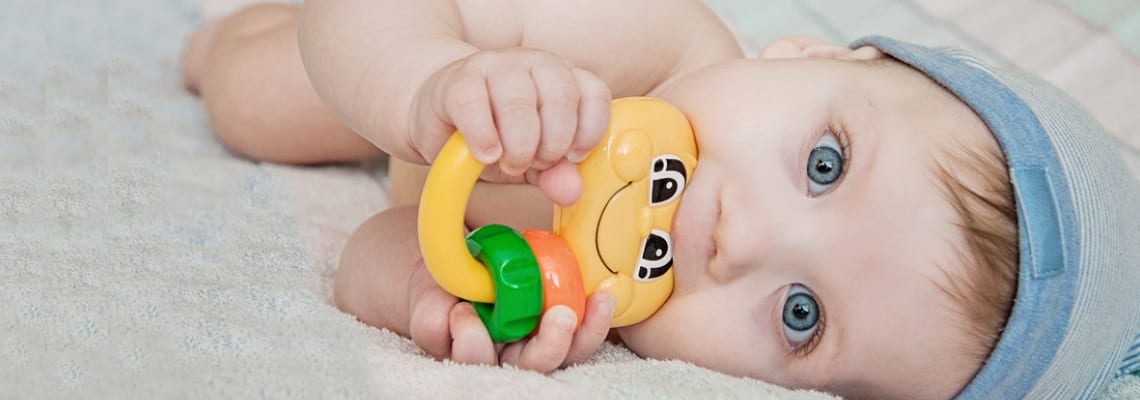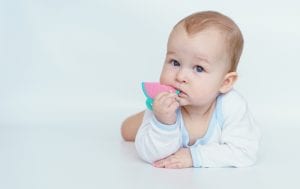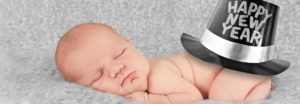
About six months after your baby is born, you may begin to notice signs of teething. Babies are born with all 20 of their primary teeth right below their gum line. Usually between six to 12 months of age, their teeth will begin to emerge. By the age of three, children will usually have their full set of baby teeth in place.
What is Teething?
Teething is when the teeth are actually coming through a baby’s gum line. This can be a time filled with frustration for both parents and babies. By knowing what to expect and some tips to help sooth your little one can help to make the process all a little less painful.
How it Occurs
While teething usually occurs between six to 12 months of age, it is possible that teething could begin as early as three months. The first teeth that usually appear are the two bottom front teeth, known as the central incisors. Within about four to eight weeks after their appearance, the four front upper teeth will arrive. These teeth are known as the lateral and central incisors. One month after this, the lower lateral incisors will likely appear, these are the two teeth that surround the bottom front.
After these teeth make their way through the gums, it is usually the first molars and pointy teeth in the upper jaw to appear. By the time your child is three years old, it is likely that they will have all 20 of their primary teeth in place.
Signs of Teething
Once your baby begins to teeth, you may notice the following side effects:
- Fussiness – crying spells, cranky for weeks
- Drooling more than usual
- Loss of appetite
- Trouble sleeping
- Irritability
- Slight raise in temperature
These are all normal things that your baby may go through during this time. However, if you notice that your baby’s temperature becomes a fever, rash, or experiences diarrhea it may be time to visit the pediatrician.
Tips to Help Soothe a Teething Baby
 When teething begins you may notice that your child’s gums are tender and sore. There are many different things that you can try to help make this transition period easier on both baby and yourself:
When teething begins you may notice that your child’s gums are tender and sore. There are many different things that you can try to help make this transition period easier on both baby and yourself:
- Rubbing– You can try to gently rub your baby’s gums with a clean finger, a small cool spoon, or even a moist gauze pad.
- Teether – Picking up a clean teether or teething toy will give your baby something to chew on to help with the discomfort. Try to find teethings made from solid rubber. It is best to avoid teething toys filled with liquid or plastic toys as they can break and are unsafe for baby.
- Avoid tying a teething ring around any of your baby’s body parts, as this could get caught on something or strangle the baby.
- Wipe – Gently wipe your baby’s face often with a clean wet cloth or baby wipe to help remove the drool that can occur. This can help to prevent rashes from developing.
- Washcloth – You can also freeze a wet washcloth for 30 minutes and use this as a teething aid. Try to remember to take it out of the freezer before it becomes too hard. The washcloth should be cleaned after each use.
- Acetaminophen – If your doctor gives you the OK and your baby seems irritable then try giving them a dose of acetaminophen or ibuprofen to help ease discomfort. This should only be considered for babies that are at least six months or older.
Some things to avoid are:
- Never place an aspirin against the tooth of your baby
- Do not rub alcohol on your baby’s gums
- Make sure to avoid using teething gels and tablets as they are not safe for babies
- The FDA recommends that benzocaine products such as numbing gels or teething tablets should not be used for children younger than 2.
Caring for Your Baby’s Teeth
It is important to take care of your baby’s teeth for their long-term dental health. Even though their primary teeth will fall out, tooth decay can make them fall out more quickly than they should. This could cause gaps before the permanent teeth are ready to arrive. These gaps may cause the teeth to crowd together and cause the permanent teeth to come in crooked and out of place.
Before your baby’s first tooth comes in, take the time to wipe your baby’s gums daily with a clean, damp washcloth. Or you can brush them gently with a soft, infant-sized toothbrush and water. Do no use toothpaste quite yet!
Once their first tooth comes in, then you can begin to use a small fluoridated toothpaste to brush the tooth. Try to avoid using any more than a pea size of toothpaste to help avoid the child swallowing it. If they swallow too much toothpaste, it can be harmful.
By the time your child becomes one, the American Dental Association recommends that you bring your baby to see a dentist. This can help to prevent any potential problems and to help learn proper preventative care.


